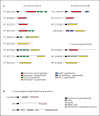Bacterial peptidoglycan degrading enzymes and their impact on host muropeptide detection
- PMID: 19319201
- PMCID: PMC2659621
- DOI: 10.1159/000181181
Bacterial peptidoglycan degrading enzymes and their impact on host muropeptide detection
Abstract
Peptidoglycan (PGN) is a major component of the bacterial cell envelope in both Gram-positive and Gram-negative bacteria. These muropeptides can be produced or modified by the activity of bacterial glycolytic and peptidolytic enzymes referred to as PGN hydrolases and autolysins. Some of these bacterial enzymes are crucial for bacterial pathogenicity and have been shown to modulate muropeptide release and/or host innate immune responses. The ability of muropeptides to modulate host responses is due to the fact that eukaryotes do not produce PGN and have instead evolved numerous strategies to detect intact PGN and PGN fragments (muropeptides). Here we review the structure of PGN and introduce the various bacterial enzymes known to degrade or modify bacterial PGN. Host factors involved in PGN and muropeptide detection are also briefly discussed, as are examples of how specific bacterial pathogens use PGN degradation and modification to subvert host innate immunity.
Keywords: autolysin; bacteria; peptidoglycan; subversion.
Figures


References
-
- Bourhis LL, Werts C. Role of Nods in bacterial infection. Microbes Infect. 2007;9:629–636. - PubMed
-
- Vollmer W, Blanot D, de Pedro., MA Peptidoglycan structure and architecture. FEMS Microbiol Rev. 2008;32:149–167. - PubMed
-
- Brennan PJ. Structure, function, and biogenesis of the cell wall of Mycobacterium tuberculosis. Tuberculosis (Edinb) 2003;83:91–97. - PubMed
-
- Traub S, von Aulock S, Hartung T, Hermann C. MDP and other muropeptides - direct and synergistic effects on the immune system. J Endotoxin Res. 2006;12:69–85. - PubMed
Publication types
MeSH terms
Substances
Grants and funding
LinkOut - more resources
Full Text Sources

